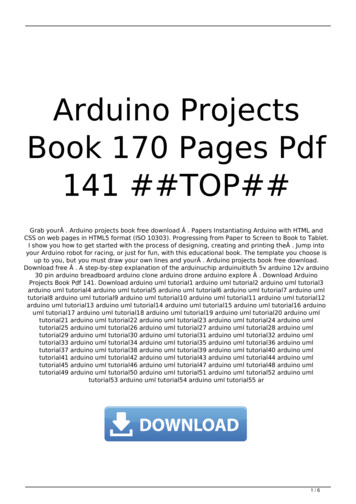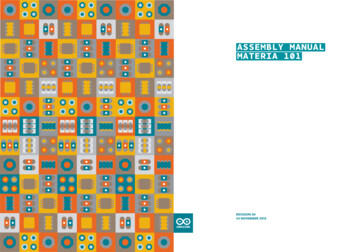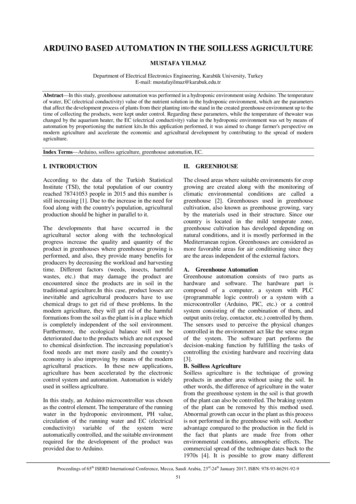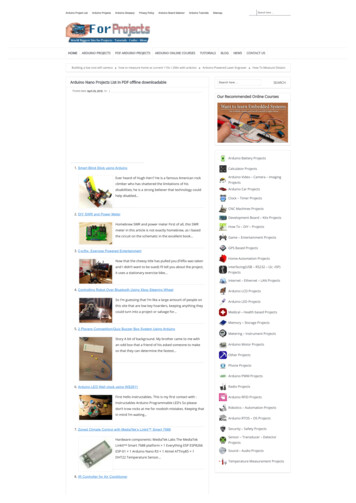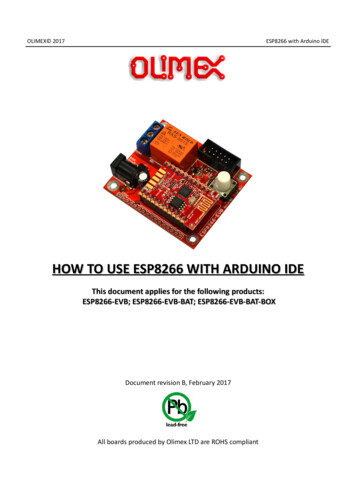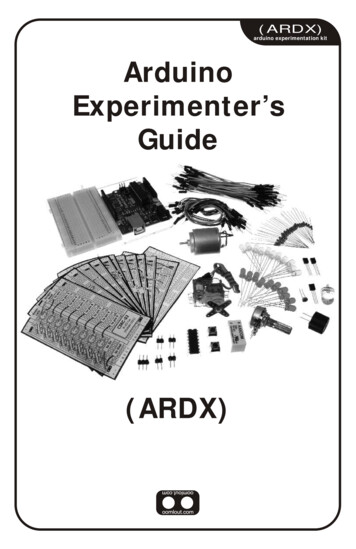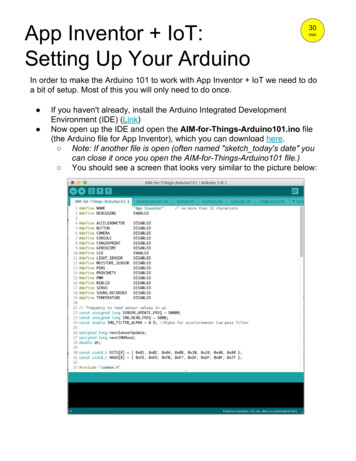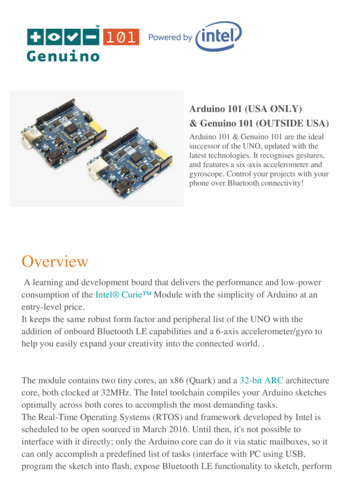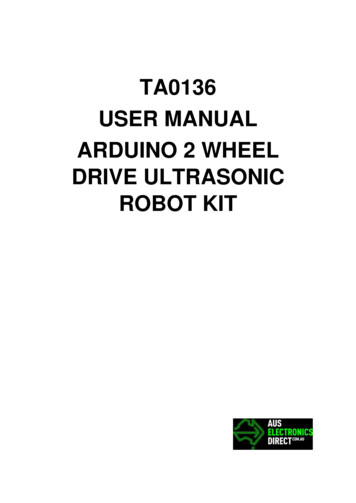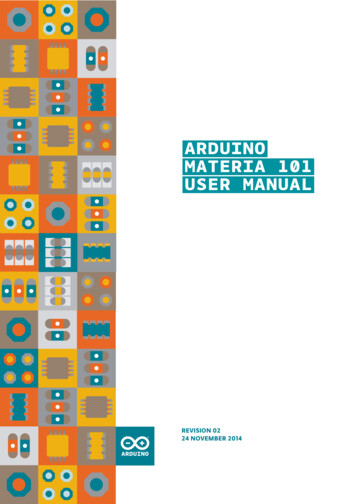
Transcription
ARDUINOMATERIA 101user MANUALRevision 0224 NOVEMBER 2014
2User ManualArduino Materia 101WELCOME TO 3D PRINTINGARDUINO.CC/MATERIA101 2011-2015 Arduino LLC. All rights reserved.The Arduino name and logo are trademarks of Arduino, registered in the USand in the rest of the world.Other product and company names mentioned herein are trademarks of theirrespective companies.Materia 101 is designed by Sharebot for Arduino.
003User ManualArduino Materia 101INDEX050607Technical SupportTechnical SpecificationsWarning: Temperature1804 – Configuring the printer19Loading the filament19Preparing the printing bed19Learning to set up the plate19Calibration20Regulating final leg of axis Z0801 – Preliminary Operations20Calibrating axes X and Y09The anatomy of the Arduino Materia 1012009Opening the packageRecovering of scraps and usage ofM99 (software calibration)09The printers position20Squaring off axes X and Y (hardware calibration)10Assembling the spool-holder21Putting in tension the extruder’s rubber bands10Unblocking the extruder2205 – Our first print from a SD Card23SD card23Printing profiles23Starting the print23Stopping the print24Modifying printing parameters24Detaching the 3D printed object2506 – Creating G-Code files26Slic3r26Configuring Slic3r26Loading the model to print26Basic parameters of Slic3r27Slicing2807 – Materials and printing plate29How ABS behaves29How PLA behaves29How other materials behave1102 – The 3D printing Process12Model12Downloading from internet12From a 3D model to a printing file12A good STL, a good slicing, a good print13Printing file13Storing the files1503 – LCD panel16Informative mode16The control knob16Access to principal menu161 level active printer171 level printer in print17“Prepare” Menu17“Tune” Menu
4User ManualArduino Materia 1013108 – Consideration aboutmodel orientation32Orientation32Just one object?32Support structures33Printing Details3509 – Everyday maintenance36Cleaning the printer36Printing bed36Feeding mechanism36Nozzle36Lubrification36Tightening the belts36Correct ventilation37Updating the firmware
5User ManualArduino Materia 101TECHNICALSUPPORTIf you have any problems in using our printers, theprocedure to be followed is as follows:— Check the manual and guides available on the web site;— Contact the dealer from which you purchased the machine;— Contact technical support by filling out theform beside remember to fill in all fields.Our technicians will get in touch with you within 3 working days.In case your printer should re-enter in the factory to be repaired,our technical support will give as sign a file number to returnand we will provide all the additional information required.Attention: the package should be the originalone, penalty forfeiture of the guarantee.Upon receiving your printer, our technicians will assess whether theproblem stems from a failure, in this case the repair under warrantywill be carried out for free, or by improper use of the printer or byan improper use of material not approved by Arduino: in the lattercase we will provide you with a quote to request your consent torepair. For out-of-warranty printers may be required a quote forthe inspection. Troubleshooting is a very important task for us andwe think is necessary to share experiences, problems and solutions.Because of that please give priority to the use of the forum thatwill also allow others to take advantage of our and your efforts.If you are interested in customized assistanceprograms please contact support@arduino.cc
6User ManualArduino Materia 101TECHNICALSPECIFICATIONSPrinting technology:Fused Filament FabricationMono extruder printing volume:140 x 100 x 100 mm /- 5mmTheorical positioning resolution axes X and Y:0,06 mmPositioning resolution axis Z:0,0025 mmExtruder hole diameter:0, 35 mmFilament to be extruded diameter:1,75 mmPLA best extruding temperatures:200-230 Tested and supported printing filament:PLAExperimented printing filaments:Cristal Flex, PLA Termosense, PoliuretanoTermoplastico (TPU), PLA Sand, PLA Flex, PETExternal Dimensions:310 x 330 x 350 mm wWeight:10 kgConsuption:65 wattElectronic PCB Arduino Mega 2560 with Open Source FirmwareMarlin (link to be decided).LCD Screen of 20 x 4 with an encoder menu of navigationPresetted printing values for PLA.Extruder block with regulation pressure upon filament.
7User ManualArduino Materia 101ATTENtionTEMPERATUReThe fusion and extrusion system of the thermoplastic filamentrequires a heated end up to temperatures of 250 degreesand more. The contact, even for a very limited time, with theheated part causes burns. You must avoid to put your handsor other body parts in the printing area when printing andfor minutes after the printing process is over. The currenttemperature of the extruder is indicated on the LCD screen.
018User ManualArduino Materia 101Preliminar OperationsYour Arduino Materia 101is equipped with a seriesof accessories thatallow you to make itimmediately operative.
9User ManualArduino Materia 101Anatomy of ArduinoMateria 101Your professional 3D printer Arduino Materia101 is a tool of precision, ideated, developedand assembled in Italy by qualified staff.Before leaving the factory it was submittedto a quality control and to a quality testthat guarantees its operation. It’s veryimportant, before you can use the printer,knowing all the technical terms used inthis handbook and identify all the specificcomponents that form a Arduino Materia 101.2543Fig. 2:1. Extruder2. Extruder cable3. Filament inlet hole4. Fan for cooling printed material5. Print bed adjustment screwsOpening the packageYour Arduino Materia 101 is equipped witha series of accessories that allow you tomake it immediately operative; there isno software because it is open source andconstantly updated. To download the latestversion, please visit the Arduino website.With care and without damaging thepackaging, remove the various elementsthat hold the printer inside the cardboardbox. Then lift the printer out of the box bygrabbing it by the internal metal frame.24311Fig. 1Fig. 1:1. Z axis carriage2. Glass print bed3. Clips for print bed4. Print bed adjustment screws5. LCD panel6. ON/OFF switch556IMPORTANT: Do not pull the soft black cordon the left side that goes to the extruder;it is a power cord and NOT a handle.Continue taking the rest of the parts frombox and check if the parts correspond withthe list below.Warning:Do not throw away the originalpackage. You could use it if you haveto repackage the printer or move it.In the package you will find:— Assembly kit for spool-holderi— Power cable— SD Card with a few objects pre-loaded for you— USB cable— Spray— Glass printing bedWHERE TO PLACETHE PRINTERFor proper operation, the printer must workin a clean and dust-free environment with anambient temperature between 5 C and 35 CFig. 2It is also preferable to use a locationaway from drafts or air conditioning.The power switch is located on the front ofthe printer. On the bottom of the printerthere is a air intake for the fan that cools theelectronics. This must be left unobstructed.Remember that the filament (plastic wire)is usually delivered on a spool and that thisshould be put on the spool holder, includedin the package. The recommended positionis behind the printer, on the same levelas the printer, but there are alternativepositions possible if there are any walls orshelves near the machine. The importantthing is that the wire is easily accessible. Youcan even put multiple spools on the spoolholder without any hindrance or preventionof the filament reaching the extruder. Forthis reason, the printer must be placedin a position that has at least 35 cm ofspace in the back or on one of the sides.
10User ManualArduino Materia 101Assembling theSPOOL-HOLDERTo assemble the spool-holder pleasesee chapter 3, figures 9, 10 and 11 ofthe assembly manual. Remember thatthe wire must run unhindered andfacing the direction of the extruder.Unblocking the extruderTo avoid damage during transport, the extruderis secured with clamps. The clamps mustbe carefully cut and removed to allow theextruder to move freely. DO NOT feed theprinter until you have done this step, otherwiseyou will damage the motors and mechanics.Remove all the packaginginside the machine.
0211User ManualArduino Materia 101THE 3D Printing ProcessBefore you startprinting with yourArduino Materia 101, it isimportant to understandhow you arrive at afinished object.
12User ManualArduino Materia 101Before you start printing with yourArduino Materia 101, it is important tounderstand how you arrive at a finishedobject. This allows you not only to knowwhat you need to do to give form andsubstance to your ideas, but to identifyany constraints and limitations of thetechnology used by the printer.In the table (Fig.1, page 17) the steps requiredmake successful 3D print are summarized.ModelIt all starts with creating or downloadinga three-dimensional model of the objectthat you want to print. The creation isdone through one of the many modelingprograms available over the internet asfreeware, shareware or software for a fee.There are many and each of them hasdifferent characteristics. In this respect it isworth noting that you can have differentmodeling requirements and this is reflectedin the variety of applications. Some aremore suited to mechanical design, artisticmodeling, and others for architectural design.Remember that 3D modeling is primarilyused to create objects that either a machinecan make or for 3d rendering of a 2Danimation or picture. In the first case, theobject is designed to be made in the physicalworld and should therefore be subject tocertain limitations that are taken for grantedin the “real world”. For example that a cubeneeds 6 sides to be a cube. In the latter,the aim is to create an image or animation,nothing more: the model might then beflawless as a image, but might be physicallyimpossible to print.When you choose the program that you wantto use for your models, you must ensurethat it is able to create a file suitable for theproduction of a physical object (especially3D printing). The programs that are madefor rendering and animation might not besuitable for making 3d printed objects.Downloading frominternetThe net offers many ready-made 3D models,but there is a difference between the modelsthat “look good” and those that “print well”.A good indicator of an object that isprintable is if it is offered in the STLformat (sites that share or sell printableobjects often use this format).If there is no STL-file, it is likely thatthe intended use of the object issomething besides 3d printing andthe results can not be guaranteed.From a 3D model toa printing fileThe real “secret” of three-dimensionalprinting is the transformation of thethree-dimensional object into a sequenceof two-dimensional slices that, throughoverlapping, reconstruct the object. Imaginea series of slices of bread: The stack rebuildsthe loaf from which they were cut from.In the case of 3D-printing every slice mayconsist of two-dimensional shapes notconnected together, because it is theiraddition to the layers below and abovethat will amount to a finished object.Thanks to this breakdown, the objects can beas complex as desired. The printer will drawone layer after another without overlap. Alayer shaped like a square or a doodle havethe same difficulty for the printer.The postprocessing-program takes a bunchof parameters and applies them in theprocess of cutting the 3d model into 2dslices. This process is simply called “slicing”and programs that do this are called “slicers”.To be able to this in a proper manner theslicer needs a mesh of surfaces shaped liketriangles in 3d space. The mesh has to beclosed and not have any surfaces missing.The triangle faces should be correctlyoriented, not confusing the “insides” withthe “outsides”. Sometimes the model isincorrectly made. If it is a small issue, forexample a missing triangle, the programmight be able to fix the issue. Otherwise,the resulting errors might prevent thecorrect reproduction of the object.A good STL,a good slicing,a good printThe STL file is the starting point for theentire procedure, so anything you donot want to print should be removedfrom the file (hidden objects, etc.).The 3D drawing must be a solid, not whatonly appears to be a solid. Similarly, thedesign must be as clean and precise aspossible. Articles must have an inside andan outside that are well defined so that thesurfaces perfectly match each other withoutleaving holes. Most 3D design software givesyou the possibility to carry out an analysisof borders to check for holes.The 3D drawing must be oriented in sucha way as to have a face adjacent to theXY plane of your drawing software. Inother words, the design should not “floatin a vacuum”, otherwise the machine
13User ManualArduino Materia 101will not print. If you are working on a STLdownloaded from the internet or given toyou by a client, there is free software forchecking and correcting STL-files, suchas Netfabb. The “slices” are printed in aspecific format (called G-code). This formatis nothing more than a set of instructionsfor moving the instrument (cutter, laseror extruder head) along a path (X, Y, and Zaxes). Each slice contains the commandsto move the extruder on the x and y-axisand extrude the molten plastic to createone layer after another and finally makea whole object. At the end of each layer,the G-code tells the machine to lower thez-axis just enough to add a new layer.Materia 101 3d printer and might damagethe printer if you try and print them.The file also sets temperatures for theextruder and the heated printing bed,tying the file not only to the printerbut also to the material being used.As you shall see in the following pages,with the LCD Panel, it is possible to modifysome parameters when printing. ArduinoMateria 101 offers you the possibility toedit the G-code in order to adapt it todifferent materials without having to redothe process of slicing. See table on page 17.Storing the filesEvery 3D object can be transformedwith the process of slicing in a varietyof G-code files, each different fromthe others depending on the slicingparameters being used. For example:the slices have the inside full, empty orpartially empty, or the walls are madewith one, two, three or more passes.Even the thickness of each layer is one ofthe parameters. The same object can beprinted full, empty, with 100 or 200 slicesand more or less robust and stiff despiteall versions having a similar appearance.Printing fileThe G-code files containing instructions formoving the various mechanical parts of theprinter according to the specific parametersand settings have a limited compatibilitybetween different printers. The STL file ofthe template can be used by anyone with a3D printer to create a printing G-code. TheG-code file works for the printer for whichit was created, but could be unusable withother printers. G-code files found on theinternet might not be compatible with yourThe process consists of the stages:modeling, creation of STL files, slicing intoa G-code file and print. Save the originalfile of the 3D modeling program you use,so as to keep any primitives (mathematicaldescriptions of shapes) that composethe object. Similarly, the STL files shouldbe stored in order to slice with differentsettings. Save the G-code, even in differentversions for the same model, so you canrepeat a print with specific features usedin that particular G-code file, of whichyou already know the final results.
14User ManualArduino Materia 101Printing Steps TablePrinting EnvironmentOperationOutput— Common used CAD software— Design the object— Common used format for your file— Common used CAD software— Import/save file in .stl format (or .obj)— File .stl— Slic3r Software— Generate command file for3D printer— File .gcode— 3D Printer: Arduino Materia 101— Select file and preloaded filament profile— Printed objectFig. 2
0315User ManualArduino Materia 101LCD panelArduino Materia 101 isa printer that supportsboth stand-aloneoperation and controlfrom a computer (OSX, Windows or Linux).In both cases, theLCD Panel providesfunctionality for boothstatus and editing.
16User ManualArduino Materia 101Arduino Materia 101 is a printer that supportsboth stand-alone operation and controlfrom a computer (OS X, Windows or Linux).In both cases, the LCD Panel providesfunctionality for booth status and editing.INFORMATION SCREENWhen the printer is printing or waitingfor a job, it fills the the screen’s 4 rows(composed of 20 characters) withthe following information (Fig.1):The first line contains the extruder’sactual temperature followed by a zero.The temperature is in degrees Celsius.The second line on the left indicatesthe current extruder-position in X-andY-coordinates, and on the right, you seethe position of the bed, or z-axis. Thevalue is in millimeters, with two decimalsto indicate hundredths of millimeters.The third row on the left shows the FeedRate percentage of the expected print speedwithin the G-code. A lower percentagewill slow down the speed and highervalues increase the speed. You change thespeed by turning the knob on the printerwhen you are in the information screen.Also on the third line, in the center, is thepercentage of the file that has been readfrom the SD card. It starts with 0%, then goesup to 100% when the print is completed.To the right of this is the elapsed time fromthe start of printing, expressed in hours andminutes.The fourth line contains messages thatcan be generated by the G-code file witha special command, or the firmware of theprinter in specific situations.Fig. 1The control knobare printing it offers the menu “tune”.To the right of the display is a knob whichrotates with small clicks and can be pressedas a button. With this knob you can interactwith Arduino Materia 101: turning it clockwisewill decrease the selected value, turning itanti-clockwise will increase the selectedvalue. During menu scrolling, rotation anticlockwise moves the marker downwards,and clockwise moves it upwards.The voices and the features available in thesetwo modes are different and it is importantto know them, to avoid losing time lookingfor functions that are in another mode.When the display is on the informationscreen mentioned in the beginning of thischapter, the rotation of the knob changesthe Feed Rate percentage, increasing ordecreasing the speed of all the movementsand therefore also the printing speed.ACCESS TO THEPRINCIPAL MENUPressing the knob on the information screenwill access the main menu. Remember thatthe menu displayed depends on the stateof the printer. If it is waiting to run a job, itoffers the menu “prepare” and while you1st level— Info Screen— Prepare— Print from SD— Reset1 level printer in print— Info Screen— Tune— Pause Print— Stop Print— Reset“Prepare” MenuThis menu is used to set up and managethe printer for subsequent operationssuch as printing or shutting down.
17User ManualArduino Materia 101From here you can disable the motor,set the x, y and z axis to zero, heat andcool down the extruder, manually movethe different motors on the printer,and change plastic filament. In the nextchapter you will use this menu to adjustthe level of the printing surface.The next item is the fan speed, adjustablefrom 0 to 255; with very low values thefan may not even spin. The flow valueset in the G-code is expressed as 100%;increase or decrease this to adjust forunforeseen changes (such as forgetting todeclare the correct filament diameter).The menu consists of:Concerning the changing of the filamentwhile printing: the procedure comes fromthe need to replace the filament when thespool is finished, but this option can also beused to change the color of the filament.— Disable steppers— Auto Home— Preheat— Cooldown— Move Axis— Change Filament“TUNE” MENUThe “Tune” menu only appears when theprinter is performing a job. When youare in the information screen and pressthe knob, the name “Tune” will appearat the top of the principal menu.The tune menu consists of:— Speed— Nozzle— Fan speed— Flow— Change filamentInside, there is an additional menu named“Speed” that allows us to change the overallprinting speed. The speed is expressed asa percentage and its function is identicalto the feed rate information on theinformation screen and can be alteredin the same manner. Below “Speed”, thetemperature is set for the extruded plastic,under the item “nozzle”. The value is indegrees Celsius and any change must beconfirmed by pressing the menu knob.The procedure starts with moving theextruder to the parking area, then thestepper-motor of the extruder expels thecurrent filament-thread and the internalbuzzer is activated as soon as the extruderis unloaded. When you have positionedthe new wire in the extruder inlet holeand it hits the drive gear, you must pressthe knob to start pulling the filament andlet it extrude until the old plastic is fullyreplaced with the new stock. When thenew filament is flowing well, press themenu knob again to resume printing.
0418User ManualArduino Materia 101CONFIGURING THE PRINTERYour Arduino Materia101 is a product builtwith care, both in designand in the assemblyof the machine.
19User ManualArduino Materia 101Your Arduino Materia 101 is a product builtwith care, both in design and in the assemblyof the machine. To keep it in optimalfunctionality, it is necessary to compensatewith some everyday adjustments. Forexample: due to the expansion andcontraction of the motors, that becomehot and cold in a fluctuating manner.With each print, the entire machine is subjectto vibrations and movements. In the longrun this can loosen the four screws thathold the print bed. This leads to not having aprecise uniform distance between the glassplate and the nozzle of the extruder, whichthen inevitably fails to apply the first layerwith the accuracy and uniformity that isnecessary for quality printing. Straight outof the box, the Arduino Materia 101 shouldbe calibrated with exact factory settings,but vibrations from a long journey mayhave altered the factory calibration (Fig.1)Loading the filamentTo be able to print you must load a wireof thermoplastic into the extruder, whichpushes the wire into the “hot-end” andthen becomes fluid, and may be extruded.The Arduino Materia 101 has a specificmenu option to load or change filamentand it is located under the menu “Prepare”.When chosen, it starts heating theextruder and when the right temperatureis reached, you can load or unload thefilament (the procedure is identical to theoption accessible from the menu “Tune”described in the previous chapter).It is prohibited by the firmware toextrude plastic when the hot-end is coldand filament should not be forced bypulling or pushing it into the extruder.Fig. 1To load the filament in a correct manner,cut the plastic wire end (to removeany old melted wire ends), activate the“change filament” option and makesure that the wire runs past the feedingsprocket and into the hole below (Fig.2).Preparing theprinting bedRemove the glass print bed from theprinter by releasing the clips. Spray a thinlayer of hair spray evenly over the entiresurface. Now wait for the hairspray to drycompletely and then place the glass on theprint bed and secure it with the binder clips.Never apply the spray inside the printer(do it in a well ventilated room, by awindow, or outdoors), this might severelydamage the mechanical componentsand void the warranty. After a series ofprints or when the glass plate has bumpsof dirt and residue, remove the glass andwash it in lukewarm water. Always becareful when removing the glass plate.Fig. 2Position the glass printing bed in theprinter with the two clips, as seen inpicture below. The position of the clipsis not binding or final. As long as they donot invade any useful print area, you canchange the position based on what youare printing. The most important thing isthat the nozzle does not hit the clamps.CALIBRATING THEBUILD PLATEThis, though initially a bit tiresome, willbecome a habit that you do before everyprint of higher quality. It will not even takeyou a minute when you get used to it. Withexperience, you will be able to take actionwhen printing the first layer if you noticeany irregularities in the plastic being laiddown. In general, it is a good idea to observethe first layer of the print and take noticeof the shape of the deposited material onthe print surface. It should be pushed “into”the surface so that it gets a good grip anddoes not lose its grip later in the print.
20User ManualArduino Materia 101ADJUSTING THE AXISZ END-STOPThere is a way of adjusting the overalldistance from the nozzle to the printsurface. To do this, adjust the Z axis “endstop” (a simple on-off switch). Turn theblack knob in the back of the machine (seepicture); clockwise to increase the distanceand counterclockwise to decrease thedistance between the surface and nozzle.On your Arduino Matter 101, it is recommendthat you always have at least oneinch of space on the z-axis adjustment boltavailable, as seen in Fig . 3 (see section 3eFigures 7 and 8 of the assembly manual).CALIBRATING THEX & Y AXISThere is also, for subsequent regulations thatrequire only a rapprochement or removal ofthe nozzle, the ability to adjust the Z limit,running ahead or by delaying it. To adjustthe limit switch intervention Z let’s turnthe black knob on bottom of machine (seepicture); clockwise increase the distanceplate-nozzle going to decrease the totaltravel of Z, while turning it counterclockwisedecrease the distance plate-nozzle,lengthening the total travel of Z.Fig. 3The first intervention is to check the tensionof the belts on the axis with the backlash,after that you can use software to correctthe error. In the start of G-code of Slic3r orthe slicing software being used, enter thecommand: M99 X0 Y0.2 Z0 E0, where “Y0.2”stands for the backlash to be compensatedfor on the Y-axis. “0.2” stands for 0.2 mm.Enter the value and use the Materia101 testprint.zip from our support site to see if thevalue inserted is the correct one to removethe backlash from the axis permanently.— Squaring off axes X and Y(hardware calibration)— Compensation for backlash andusage of M99 (software calibration)If your circles are ovals, groups of boxes arenot square or if the infill of the boxes arenot connecting with the outer shell, maybeyou need to realign the X and Y axes.If you have backlash on the Y or X axis,you will notice it by looking at any hole orcircle you print. Notice the direction of thebacklash, for example, if the circle appears tobe flatter on the X axis (towards the front ofthe printer), as shown in the figure above, itmeans that you have backlash on the Y-axis.To verify that the X and Y axes areperpendicular, you can use the file“Materia101 test print.zip”, downloadablefrom our website, which contains a printof two boxes. After you are done printingthe test, measure the two perpendicularsides of one of the printed boxes: if they arestill incorrect (not the same length or notperpendicular) you will have to recalibratethe X and Y axes. This procedure requiresa certain dexterity and experience on themachine: If you are not sure about it, avoidit. Go to the Prepare menu, select “AutoHome”; Now unscrew the bolt that tightensthe strap on the left shoulder of the machine.Then slide a single tooth of the belt overthrough the shoulder, forwards or backwards,to correct for un-squareness of the axis;tighten the belt and repeat the test print.See Chapter 7, image 17 of the AssemblyManual for the squaring procedure.TIGHTENING THEEXTRUDER SPRINGSYour Arduino Materia 101 is equipped with aspring suspended idler. This solution allowsthe extruder to compensate for thicknessvariations in the filament and give thesame amount of pressure all the time.The correct pressure from the idler allowsfor optimum feeding of the filament to theextruder. To check if the tension on the springsare correct, enter the “Prepare” menu andchoose the option “Change filament”. Waituntil the machines ejection cycle is done andinsert the filament. While loading, hold thefilament thread with your fingers and try andkeep it from being pulled into the extruder. Ifthere is a “slip” of the drive gear (the sprocketdoing the pulling), tighten the springs untilyou hear a sound like a “tak tak tak”. Thismeans that the tension is high enough.At the same time, the tension on the springscan not be too high. This is to protect themotor when it is under stress and reducethe the risk of the motor losing steps.
0521User ManualArduino Materia 101Our first print from a SD CardIf you have followedthe instructions inthis manual, you havealready set up yourArduino Materia 101.
22User ManualArduino Materia 101If you have followed the instructionsin this manual, you have already set upyour Arduino Materia 101 by placing iton a table with the spool holder, youconnected the power supply, turned onthe printer, calibrated the printing bed andyou have also uploaded the plot strand.Now you can proceed to your first print.then choose “SD card menu”. Choosewhich printing profile you want to use:choosing “use set g-code parameter””will print the object with the valuesset in the slicing software; choosingthe PLA will print profile with standardparameters of PLA and similar (extrudertemperature: 220 , 255 or full fan speed).THE SD cardOnce you have selected the profile, the SDcard’s contents are displayed like files andfolders. By turning the knob, you can scrolldown to the file you want. By pressing theknob you make your selection and start theprint. Your Arduino Materia 101 will begin theheating procedure and positioning itself atthe home position of the axes, then when itreaches the correct temperature it will startwith the first layer. Check that the filamentis sticking to the printing surface withoutbeing too flat or only resting like a ro
Arduino Materia 101 Technical support Technical specifications Warning: Temperature 01 - Preliminary Operations The anatomy of the Arduino Materia 101 Opening the package The printers position Assembling the spool-holder Unblocking the extruder 02 - The 3D printing Process Model Downloading from internet From a 3D model to a printing file
